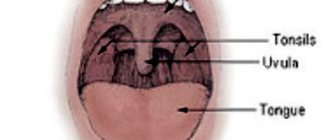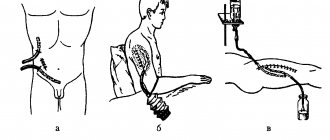Allergic laryngeal edema is a pathological condition characterized by inflammation of the mucous tissues of the larynx and narrowing of its lumen (stenosis). It occurs due to the body’s contact with factors hostile to it – allergens.
Author:
- Sadykhov Rahim Agalarovich
ENT pathology expert
2.46 (Votes: 37)
Allergic laryngeal edema is a pathological condition characterized by inflammation of the mucous tissues of the larynx and narrowing of its lumen (stenosis). It occurs due to the body’s contact with factors hostile to it – allergens, which cause a negative immune reaction. The main danger of edema is depression of respiratory function. As the lumen of the larynx narrows, breathing becomes difficult, which provokes oxygen deficiency, which is life-threatening.
What is the larynx?
Many people, even those who know anatomy well, may confuse the larynx with the pharynx, throat, or trachea. The larynx is not a separate organ, but a section of the respiratory system that is especially important and very complex in structure.
The larynx is located in the upper part of the trachea, at the level of 4-6 cervical vertebrae. Its position is ensured by its attachment to the thyrohyoid gland and connection with the hyoid bone. Air passing through the larynx forms vibrations in a person’s vocal cords - from here the human voice is born1.
The structure of the larynx includes a combination of many cartilages (epiglottis, thyroid cartilage, cricoid cartilage and others) with muscle joints and ligaments. Inside, the larynx is covered with a mucous membrane, which is so loved by viruses and various bacterial infections.
Swelling of the throat with sore throat
International medical practice classifies inflammation of the tonsils as acute tonsillitis. However, the more familiar name for us “angina” (translated from Latin means “squeeze, strangle”), quite accurately describes the ongoing pathological process. Swelling of the throat during sore throat partially blocks the airways, and the patient begins to choke. This rather serious local complication is accompanied by:
- stridor (difficulty noisy breathing);
- pain when swallowing in the absence of cough;
- swelling of the neck, change in color of the skin of the face (pallor, and then cyanosis).
Causes of laryngeal edema
The mechanics of edema are simple. In the larynx, as a result of one or another effect, there is a sharp or gradual increase in the volume of mucous tissue, which begins to block the lumen of the respiratory tract. In medicine, this condition is called laryngeal stenosis2.
The reasons that can cause swelling of the larynx are extremely varied. It is generally accepted to divide laryngeal edema into two main types - inflammatory and non-inflammatory.
Pathologies and inflammatory diseases that provoke laryngeal edema include:
- Viral and bacterial infections - acute tonsillitis (tonsillitis), chronic tonsillitis, pharyngitis, tracheitis, inflammatory diseases of the oral cavity, abscess and most diseases of the ARVI group.
- Chronic infectious diseases - tuberculosis, syphilis and others.
- Acute infectious diseases - scarlet fever, measles, typhus.
- Vasomotor edema and allergic edema of the larynx. The cause is an allergy familiar to many, which provokes inflammation of the mucous membrane of the larynx. The laryngeal mucosa is very sensitive to the influence of allergens and the reaction in the form of swelling is quite common.
Non-inflammatory causes are no less diverse; these include swelling due to mechanical, chemical (toxic) or thermal effects. Burns from food that is too hot or cold is a common cause, especially in children. Swelling can also be caused by a foreign object in the throat or a piece of food.
In addition to the nature, inflammatory or non-inflammatory, there are two forms of edema - limited and diffuse (spill). With limited swelling, a person may not even be aware of the condition of the larynx, he is not bothered by severe pain and can breathe freely. Diffuse edema is characterized by severe narrowing of the larynx and damage to a large area of mucous tissue; breathing is almost always difficult2.
First aid for Quincke's edema.
How to relieve Quincke's edema? The first thing you should do when you find yourself next to a person with signs of angioedema is to call an ambulance.
What to do in case of Quincke's edema before the doctors arrive?
- First, unbutton the patient's clothes, loosen the tie, remove chains, beads, etc., thereby ensuring air flow. If you are indoors, open a window to let fresh air in.
- Make the patient more comfortable and try to calm him down by saying that doctors will arrive soon and begin treatment. This condition puts the patient into shock, which only worsens respiratory failure.
- If the problem began due to contact with an allergen, eliminate it if possible.
- Give the patient a tablet of any antihistamine that is in your home medicine cabinet. If the person cannot swallow, crush the tablet and place it under the person's tongue.
- Give the patient food more often if he can swallow, preferably with mineral water.
- If swelling is caused by contact with an allergen, give the patient activated carbon, Enterosgel or Polysorb to reduce the concentration of the allergic substance in the body.
- The patient's feet should be kept warm. You can place them in a bath of warm water or wrap them well.
- Place any vasoconstrictor drops into the patient's nose.
- It is necessary to measure the patient's blood pressure, and if it falls below 90, it is necessary to administer adrenaline to the patient.
Even if the patient feels better as a result of the measures provided, under no circumstances should one refuse medical care.
Main symptoms of laryngeal edema
Despite the fact that in most cases laryngeal edema itself is a symptom, it is not always possible to detect it promptly. Professional medical diagnostics or special signs characteristic of laryngeal edema3 come to the rescue:
- Severe cough, most often of the “barking” type;
- Hoarseness, loss or severe changes in voice - given that the human voice apparatus is located in the larynx, this is a quite obvious sign;
- Gradual progression of suffocation, breathing becomes difficult.
Laryngeal edema does not always develop slowly and unnoticeably. In rare cases, an emergency condition occurs in which swelling occurs immediately (laryngospasm). In such a case, the symptoms of laryngeal edema will be pronounced:
- The appearance of cyanosis on the face;
- Severe suffocation and oxygen starvation, complete asphyxia is possible.
Additional signs of the development of laryngeal edema may include more general symptoms that are characteristic of many other diseases:
- Temperature increase;
- Feeling of a foreign object in the throat, while the exact position cannot be determined;
- Discomfort and pain in the larynx area, especially when swallowing;
- Intoxication of the body - general weakness, nausea, headaches, muscle pain, etc.;
- Shortness of breath, even at rest.
Why does the mucous membrane of the throat swell?
Mechanical damage
Swelling of the throat mucosa due to injury is observed when damaged by hard objects, pieces of food, or fish bones.
Small foreign bodies can get stuck between the ridges, arches, and tonsils in the posterior parts of the oropharynx. The patient complains of severe local pain, soreness, and the sensation of a foreign object. Upon examination, swelling and hyperemia of the affected area are revealed. With deeply located foreign bodies, there are no obvious visual changes. If the object is located in the hypopharynx, suffocation is possible. Thermal burns of the pharyngeal mucosa are usually superficial. They develop when eating too hot food or inhaling hot steam during inhalation. There is a burning sensation that intensifies when swallowing. Chemical injuries to the throat vary in severity and are accompanied by severe pain and the formation of white or gray scabs. In addition, swelling is observed after operations in the area of the oropharynx and hypopharynx.
Infectious diseases
Acute infections are one of the most common causes of swelling of the throat mucosa. The symptom is detected in the following pathologies:
- ARVI and influenza.
Swelling is insignificant, appears in the initial stages of the disease, is combined with moderate hyperemia, weakness, weakness, fever, and muscle pain. - Measles.
The sign is more pronounced in children, complemented by hyperemia and granularity of the pharynx. Occurs simultaneously with fever. After 3-5 days, the condition improves and a rash appears on the body. - Typhus and typhoid fever.
Not only the throat swells, but also the neck and lower part of the face. Peculiar hemorrhages into the mucous membrane are possible. Significant hyperthermia, severe intoxication, and rash are observed. The condition is serious. - Scarlet fever.
The throat is swollen, bright red (“flaming throat”), areas of necrotic, fibrinous or mucopurulent plaque may form. The cervical lymph nodes become enlarged, and a pinpoint rash appears on the body. - Diphtheria.
Against the background of swelling of the pharyngeal mucosa, a typical plaque forms on the tonsils. In severe cases, plaque spreads to the oropharynx and is combined with swelling of the subcutaneous tissue above the enlarged cervical lymph nodes. In the toxic form, swelling of the throat is so severe that it interferes with breathing.
Swelling and other signs of inflammatory damage to the throat mucosa, reminiscent of local symptoms of ARVI, can be detected at the initial stage of hepatitis A, secondary syphilis, and tuberculosis. There are also signs of intoxication, skin rashes, muscle and joint pain, and other symptoms.
Inflammatory ENT pathologies
Swelling of the mucous membrane is accompanied by the most common acute and chronic inflammatory diseases of the pharynx and larynx:
- Tonsillitis.
Swelling and hyperemia of the tonsils, posterior wall of the pharynx, soft and hard palate are determined. Local surface films, loose plaque or purulent foci are formed on the tonsils, reminiscent of a “starry sky” picture. Body temperature is increased. Chronic tonsillitis is manifested by repeated exacerbations, which occur with more sparse symptoms than acute tonsillitis. - Pharyngitis.
In the acute form of the disease, the swelling spreads throughout the entire pharynx; in the chronic form, it covers its upper, middle or lower part. Redness appears. The general condition suffers slightly or remains satisfactory. - Laryngitis.
Swelling of the mucous membrane is localized in the lower parts of the throat and is not visually detectable. There is soreness, scratching, tickling, burning, dry, convulsive cough, and hoarseness. After a few days the cough becomes wet. In chronic laryngitis, the symptoms are smoothed out, the disease proceeds in waves.
Swelling of the throat mucosa
Purulent complications of ENT diseases
Unlike uncomplicated otolaryngological pathologies, which are characterized by diffuse symmetrical damage to the structures of the throat, with purulent complications the symptoms are more often expressed on one side. Upon examination, a local focus is determined; the prevalence of edema depends on the severity of the process. Swelling of the throat is accompanied by the following pathological conditions:
- Peritonsillar abscess.
There is sharp unilateral pain when swallowing; in 10% of cases, bilateral damage is detected. The swelling quickly increases, the pain becomes tearing and radiates to the ear. Due to swelling and accumulation of pus, the tonsil and uvula may deviate to the side. - Retropharyngeal abscess.
Symptoms are determined by location. Along with swelling and sore throat, when the abscess is located in the upper parts of the pharynx, nasal breathing is disrupted. Abscesses of the middle and lower sections are accompanied by hoarseness, deepening of the voice, difficulty breathing, and sometimes suffocation. - Intratonsil abscess
. It is more often observed in adults suffering from chronic tonsillitis and severe somatic diseases. One tonsil becomes sharply painful, enlarges, and takes on a spherical appearance. With cold abscesses due to leukemia, there is no intense pain. - Abscess of the root of the tongue.
Swelling of the pharyngeal mucosa occurs secondarily and is a reaction to the presence of an abscess in nearby tissues. Severe pain, hyperemia in the root zone, and enlarged tongue prevail. - Abscess of the epiglottis.
Severe pain in the lower part of the throat, foreign body sensation, difficulty breathing, and nasal voice predominate. The area of maximum edema is located in the larynx.
In patients with Ludwig's angina, the inflammation is diffuse, beginning in the submandibular space and moving to the floor of the mouth. From there, the swelling spreads to the pharynx, which is accompanied by difficulty swallowing. When the larynx is involved, the voice changes or disappears. Another type of diffuse purulent inflammation is phlegmonous laryngitis. Maximum swelling and pain are observed in the larynx area, loss of speech and acute stenosis of the larynx are possible.
Allergic reactions
Swelling of the throat mucosa is accompanied by many allergic reactions. The symptom appears suddenly, combined with a sore throat, nasal congestion, sneezing, watery eyes, and itchy skin. The most common cause is contact with plant pollen, animals or house dust. This manifestation is especially pronounced in Quincke's edema, which is complemented by swelling of the face and other parts of the body, speech impairment, and wheezing stridor.
Tumors
With benign tumors of the pharynx, the symptom appears in case of trauma to the formations. Pharynx cancer is accompanied by tissue swelling during the disintegration of neoplasia and the development of inflammation of surrounding tissues. Swelling of the mucous membrane of the larynx and pharynx can occur during radiotherapy of the neck organs for oncological lesions of the larynx, pharynx, thyroid gland, and other anatomical formations of this area.
Other reasons
Due to reactive inflammation against the background of reflux of gastric contents, swelling of the throat can be observed with gastroesophageal reflux disease. The symptom is especially often detected in cases of prolonged course of the disease with the development of laryngitis, GERD during pregnancy.
Swelling, soreness, and hyperemia of the throat are typical for some acute poisonings affecting the respiratory system, including berylliosis and toxic pulmonary edema. The symptom appears at the initial stage, then manifestations from the bronchopulmonary system, myalgia, and hyperthermia are added.
Diagnosis of laryngeal edema
In most cases, an experienced doctor (otolaryngologist, pulmonologist or even a therapist) can easily diagnose laryngeal edema. A visual examination or laryngoscopy will give an understanding of the condition of the sick person’s larynx. Endoscopy will show the most complete condition of the larynx. With edema, redness is almost always present, as is swelling of the laryngeal mucosa, and the glottis will be noticeably narrower4.
However, it is not recommended to diagnose this condition yourself. A doctor should examine it, since complications or severe forms are possible, in which there is a risk of suffocation, and swelling can directly indicate the development of a dangerous disease.
4.Treatment
The measures taken vary widely in both substance and urgency. In some cases, it is necessary to resort to emergency life-saving tracheostomy and resuscitation measures; in others, corticosteroid hormones, antihistamines, diuretics, and sedatives are prescribed in accordance with existing protocols. Laryngeal edema requires mandatory hospitalization in a specialized department, a detailed examination against the backdrop of a gentle regimen; Based on the diagnostic results, therapy for the underlying disease and/or anti-relapse prevention is carried out.
First aid and treatment of laryngeal edema
If swelling occurs that causes immediate breathing problems, you need to act quickly. Man's main enemy is panic. In this case, in addition to promptly calling doctors, first aid should be provided.
The first step is to free the chest of an adult or child from any load, including clothing. If you are in a panic state, you should try to calm the person down. Next, provide access to fresh air, and, if possible, reduce the ambient temperature. If the cause of swelling is known, for example the effect of a certain allergen, then it should be blocked immediately. Spraying cool water on your face will help relieve the condition5.
Most often, a timely visit to a doctor solves everything, and treatment of laryngeal edema is as effective as possible. Having established the cause of the swelling, the doctor prescribes medications. Depending on the reasons, anti-inflammatory and antiallergic medications (antihistamines) are used. If the cause is a viral or bacterial infection, immunomodulators and antibiotics may be prescribed for the most serious bacterial infection. In case of sharp progression of edema and suffocation, drug therapy is carried out based on antispasmodic and hormonal drugs.
A person with edema should remain completely at rest, eat liquid foods and drink enough water. It is not recommended to talk a lot - you need to minimize all irritating factors. In the most serious cases, surgery may be required.
As you know, disease is easier to prevent. The same applies to laryngeal edema. The most common causes of edema are acute respiratory diseases. Viruses or bacteria enter the mucous membranes of the larynx and begin to act insidiously. Often, this happens due to insufficient strength of local and general immunity.
To maintain local immunity, doctors may prescribe immunostimulating agents. One of these drugs, but with interesting features, is a drug based on bacterial lysates, Imudon®. The effect of the drug is associated with an increase in the number of cells aimed at fighting bacteria and viruses. Imudon® has direct indications for pharyngitis and chronic tonsillitis6.
Imudon® is presented in the form of lozenges with a pleasant taste, which is especially important for children. The drug can be used from three years of age7. This form allows the drug to act at the very site of inflammation and directly influence local immunity.
Instructions
Learn more
Developed with support from Abbott to improve patient health awareness. The information in the material is not a substitute for healthcare advice. Contact your doctor. 1. Babiyak, V. Otorhinolaryngology / V.I. Babiyak, I.B. Vyacheslav // “Peter” - Study guide, manual - 2009 - Volume 2 - P. 13-30. 2. Soldatsky, Yu. Diseases of the larynx / Yu.L. Soldatsky // Pediatric pharmacology - 2008 - No. 2 - Volume 5 - P. 20-25. 3. Trukhan, D. Respiratory diseases. Tutorial. / D.I. Trukhan, I.A. Viktorova // SpetsLit – 2013 – P. 175. 4. Svistushkin, V. Application of contact endoscopy in the diagnosis of diseases of the larynx / V.M. Svistushkin, N.D. Chuchueva // RMJ – 2015 – No. 23 – P.1406-1408. 5. Gurov, A. Local therapy of inflammatory diseases of the pharynx / A.V. Gurov, M.A. Yushkina // RMJ – 2022 – No. 11 – P. 792-796. 6. Luchikhin, L. Efficacy of the drug Imudon® in the treatment of patients with acute and chronic inflammatory diseases of the pharynx / L. A. Luchikhin [et al.] // Bulletin of Otorhinolaryngology - 2001 - No. 3. – pp. 62-64. 7. Instructions for medical use of the drug Imudon® lozenges dated 07/02/2018.
RUS2157722 from 08/19/2020
Prevention
As preventative measures, as well as after an attack, it is recommended:
- strengthen immunity;
- perform moderate physical activity;
- use halotherapy and climatotherapy (stay at sea and in the mountains);
- use air purifiers;
- adhere to a diet excluding highly allergenic foods and products containing preservatives and chemical additives.
If you are concerned about breathing problems of any kind, we are always ready to provide assistance, make the correct diagnosis and begin treatment immediately. Call and make an appointment at the Ear, Nose and Throat Clinic!
Allergic swelling of the throat
Severe development is characterized by swelling of the throat due to allergies. Many substances and agents can act as allergens - dust, insect bites, animal hair, some medications, foods, etc. Allergic swelling of the throat is expressed by specific signs in addition to the main symptoms:
- nasal congestion and discharge (rhinitis);
- bronchospasm;
- diarrhea and skin rashes;
- lacrimation.
A particularly dangerous form of allergic swelling of the throat is Quincke's edema.
Clinical picture of acute laryngitis upon examination
The main method for diagnosing laryngitis is instrumental and endoscopic laryngoscopy.
For catarrhal laryngitis:
- the mucous membrane of the larynx is red and swollen
- vocal folds are pink or bright red, thickened, mobile, do not close completely
- mucous or mucopurulent secretions may accumulate, which can cause a wet cough
Depending on the form of acute laryngitis, swelling and hyperemia (red mucous), the size of the epiglottis, and narrowing of the lumen of the larynx can be expressed in different ways.
In the complicated (abscessing) form, a spherical formation with translucent purulent contents is determined in the area of the epiglottis.
With stenosis of the larynx, a narrowing of its lumen occurs.
Functions of the sky and structural features
The palate is a vault that separates the oral cavity from the nasopharynx. The structure of the palate consists of two sections - hard and soft. This organ performs an important function - it prevents food from entering the nasopharynx from the oral cavity.
In addition, receptors on the surface of the palate are associated with the larynx and take part in articulation and influence the timbre of the voice and the pitch of sounds. Thus, the inflammatory process of the upper palate disrupts all the functions of this important organ, and therefore requires mandatory treatment.
FAQ
How to treat laryngitis at home?
For uncomplicated acute laryngitis and in the first days of the disease, it is recommended:
- ensure vocal rest, eliminate whispered speech , in which the vocal folds become even more tense
- plenty of warm drinks: you can drink warm milk with soda, warm mineral degassed water, teas and fruit drinks
- if laryngitis is accompanied by inflammation in the throat, it is recommended to rinse with a solution of chamomile or calendula, as well as the use of sprays, solutions or tablets to treat the throat
- inhalations are the main method of treating laryngitis. Self-inhalation can only be done using saline solution. Other drugs for inhalation are prescribed exclusively by a doctor.
Is it possible to quickly cure laryngitis?
For acute catarrhal laryngitis caused by viruses, recovery is possible within a week. It is important to consult a doctor in time and not self-medicate so as not to worsen the condition.
What syrups and tablets can be taken for laryngitis?
The use of local drugs for the treatment of the throat in the form of lozenges, sprays and rinses is permissible only if laryngitis is caused by throat diseases. These forms of drugs do not directly enter the lumen of the larynx.
How to treat false croup in a child?
When the first symptoms of croup appear, you should call an ambulance.
Only a doctor will be able to assess the severity of the child’s condition, as well as determine further treatment and observation tactics. Outpatient observation and treatment is permissible only for grade 1 stenosis. Self-medication and the use of folk remedies are excluded in this case!
How is inflammation of the palate treated?
How to treat inflammation on the roof of the mouth, a specialist will tell you after determining the diagnosis. The following therapy methods can be used:
- If the cause of inflammation is minor damage to the mucous membrane, rinsing with decoctions of medicinal herbs is usually sufficient. Decoctions and infusions based on calendula, sage and chamomile have an antiseptic and healing effect. The herbal decoction for rinsing should be used warm.
- When the palate is affected by a fungus, patients are prescribed topical agents. The most effective are the solution and gel “Chlorhexidine”, “Rotokan” or “Stomatofit”.
- In case of severe pain symptoms, regardless of the cause of inflammation, drugs of combined action are prescribed. “Cholisal-gel” and “Kalgel” have proven themselves well.
- If a purulent inflammatory process is detected in the oral cavity, the patient is prescribed antibiotics. The minimum course of treatment is usually 7 days, but there are also stronger drugs that only need to be taken for 3 days. Along with local agents, antibacterial drugs for internal use - Sumamed, Flemoxin Solutab - can be prescribed.
- The inflammatory process of the palate is easily treatable. The earlier therapy is carried out, the less likely it is to develop complications.
How to recognize swelling of the throat
It can be difficult to understand that the throat is swollen, since the process begins inside and it is difficult to see it on your own. Symptoms of pathology:
- pain and discomfort when swallowing;
- labored breathing;
- stiffness of neck movements;
- irradiation of pain to the ear area;
- dry hacking cough;
- sensation of a foreign body in the larynx;
- change in voice timbre;
- visual increase in neck thickness.
Sometimes swelling of the throat is accompanied by an increase in body temperature. This is typical for an infectious process.








